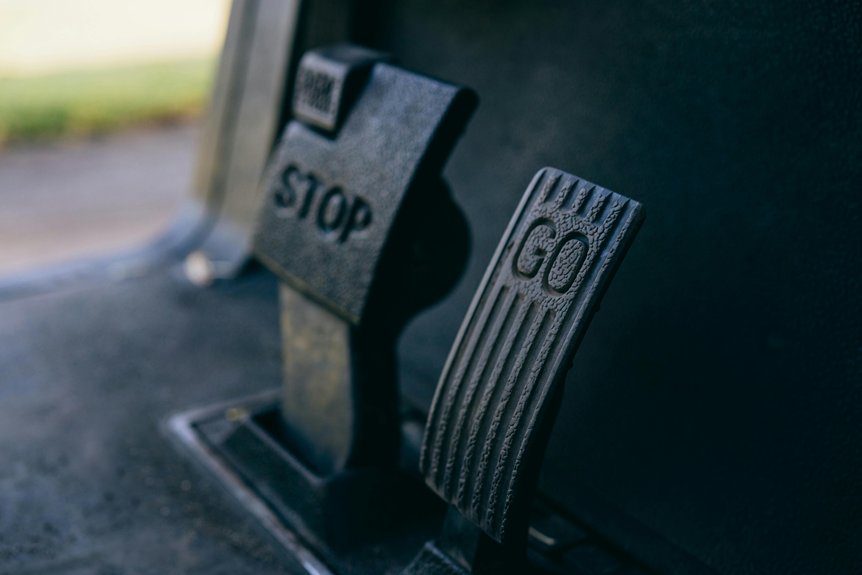Maintaining proper transmission fluid levels is essential for your vehicle’s performance, but knowing the correct way to check it can be tricky. If you don’t follow the right steps, you might miss early signs of trouble or cause damage. There’s a specific process to ensure your transmission stays in good shape, and understanding it can save you time and money. Keep going to learn the essential steps for a safe and accurate check.
Gather Necessary Tools and Safety Precautions
Before checking your transmission fluid, you need to gather the right tools and take safety precautions. Proper vehicle maintenance begins with preparing your workspace and ensuring safety gear is in place. Wear gloves and safety glasses to protect against hot fluid or debris. You’ll need a clean cloth, a funnel if needed, and possibly a flashlight to see clearly. Make sure your vehicle is parked on a flat surface, the engine is cool, and the parking brake is engaged. Taking these steps helps prevent accidents and guarantees accurate readings, making your transmission fluid check safer and more effective. Additionally, understanding the importance of transmission repair Durham NC can help you recognize when professional assistance is needed.
Locate the Transmission Fluid Dipstick
Locating the transmission fluid dipstick is an essential first step in checking your fluid level. Open the hood and find the transmission fluid dipstick, typically marked with a bright handle or labeled clearly.
Proper dipstick maintenance guarantees accurate readings and helps prevent fluid contamination. Regularly inspect and wipe the dipstick to remove dirt and debris, which can cause false readings or introduce contaminants into the fluid.
Be aware that a dirty or damaged dipstick can lead to misdiagnosis of fluid levels. Once located, you’re ready to proceed with checking the fluid, ensuring you have a clear and clean tool for accurate measurement.
Check the Transmission Fluid Level
Once you’ve found the transmission fluid dipstick, pull it out and wipe it clean with a lint-free cloth or paper towel.
Reinsert it fully, then pull it out again to check the fluid level. Confirm the fluid sits within the marked range on the dipstick.
Low levels can cause transmission issues, while high levels may lead to fluid foaming.
Also, check for signs of fluid contamination, which can indicate problems with the transmission filter or internal components.
Maintaining proper fluid levels helps prevent damage and prolongs your transmission’s life.
If contamination is present, consider replacing the transmission filter and flushing the fluid.
Inspect the Fluid’s Color and Odor
Inspecting the fluid’s color and odor is essential to assess its condition. Fresh transmission fluid is usually pinkish or red and transparent, indicating minimal fluid degradation.
If the fluid appears dark, brown, or black, it signals contamination or fluid breakdown. Odor detection also helps; a burnt smell suggests overheating or fluid deterioration.
If you notice a strong, foul odor, it’s a sign that the fluid may need replacing. Regularly checking these signs can help you catch issues early, preventing transmission problems and ensuring smooth operation.
Always inspect the fluid in a clean, clear container for the most accurate assessment.
Top Off or Replace Transmission Fluid if Needed
If the transmission fluid looks dark, smells burnt, or shows signs of contamination, it’s time to top off or replace it. Fluid replacement ensures your transmission stays smooth and prevents damage.
If the fluid level is low, perform a fluid top off using the correct type of transmission fluid. For more severe issues, a full fluid replacement might be necessary.
Regularly checking and maintaining the right fluid level helps extend your transmission’s lifespan and improves performance. Don’t ignore signs of dirty or burnt fluid; addressing them promptly keeps your vehicle running efficiently.
Always follow your vehicle’s manual for proper fluid specifications and procedures.
Conclusion
Regularly checking your transmission fluid helps keep your car running smoothly. Always park on a level surface with a cool engine before inspecting. Use the dipstick to check the level, color, and smell of the fluid, and top off or replace it if necessary. Staying attentive to these simple steps can prevent costly repairs and ensure your transmission remains in top shape. Make this quick check part of your routine maintenance. To schedule your free TransScan or to book an appointment, call us today at (919) 471-2506 or visit us online at Durham Transmission.

